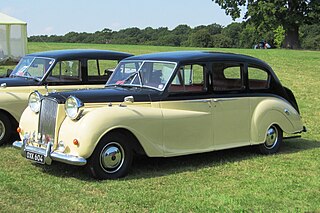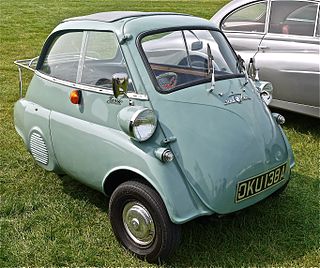
The Ford Anglia is a small family car that was designed and manufactured by Ford UK. It is related to the Ford Prefect and the later Ford Popular. The Anglia name was applied to various models between 1939 and 1967. In total, 1,594,486 Anglias were produced. It was replaced by the Ford Escort.

The Austin Princess is a series of large luxury cars that were made by Austin and its subsidiary Vanden Plas from 1947 to 1968. The cars were also marketed under the Princess and Vanden Plas marque names.

Zeta is a marque of automobile which was produced in Australia from 1963 to 1965 by South Australian manufacturing company Lightburn & Co.

The Isetta is an Italian-designed microcar built under license in a number of different countries, including Argentina, Spain, Belgium, France, Brazil, Germany, and the United Kingdom. Because of its egg shape and bubble-like windows, it became known as a bubble car, a name also given to other similar vehicles.

Berkeley Cars Ltd of Biggleswade, Bedfordshire, England produced economical sporting microcars with motorcycle-derived engines from 322 cc to 692 cc and front wheel drive between 1956 and 1960.

The Ford Zephyr is an executive car manufactured by Ford of Britain from 1950 until 1972. The Zephyr and its luxury variants, the Ford Zodiac and Ford Executive, were the largest passenger cars in the British Ford range from 1950 until their replacement by the Consul and Granada models in 1972.

The Nash Metropolitan is an American automobile that was assembled in England and marketed from 1953 until 1961.

The Hillman Husky was a line of British passenger vehicles manufactured between 1954 and 1970 by Hillman.

Trojan was a British automobile manufacturer producing light cars between 1914 and 1965, and light commercial vehicles for a short time.
The Austin Cambridge is a medium-sized motor car range produced by the Austin Motor Company, in several generations, from September 1954 through to 1971 as cars and to 1973 as light commercials. It replaced the A40 Somerset and was entirely new, with modern unibody construction. The range had two basic body styles with the A40, A50, and early A55 using a traditional rounded shape and later A55 Mark IIs and A60s using Pininfarina styling.

The Austin Westminster series are large saloon and estate cars that were sold by the British manufacturer Austin from 1954, replacing the A70 Hereford. The Westminster line was produced as the A90, A95, A99, A105, and A110 until 1968 when the new Austin 3-Litre took its place. Essentially badge-engineered versions of the Farina Westminsters were also produced using the premium Wolseley and Vanden Plas marques. 101,634 Westminsters were built.

The Vauxhall Cresta is a British automobile which was produced by Vauxhall from 1954 to 1972. The Cresta was introduced in 1954 as an upmarket version of the Vauxhall Velox, itself a six-cylinder version of the Vauxhall Wyvern. The Cresta models were the E (1954–1957), PA (1957–1962), PB (1962–1965) and PC (1965–1972). The Viscount (1966–1972) was an upmarket Cresta PC.

The Austin 7 is an economy car that was produced from 1923 until 1939 in the United Kingdom by Austin. It was nicknamed the "Baby Austin" and was at that time one of the most popular cars produced for the British market and sold well abroad. Its effect on the British market was similar to that of the Model T Ford in the US, replacing most other British economy cars and cyclecars of the early 1920s. It was also licensed and copied by companies all over the world. The first BMW car, the BMW Dixi, was a licensed Austin 7. In France they were made and sold as Rosengarts, and in the United States they were built by the American Austin Car Company. In Japan, Nissan also used the 7 design as the basis for their first cars, although not under licence. This eventually led to a 1952 agreement for Nissan to build and sell Austins in Japan under the Austin name.

Fairthorpe Ltd is a British manufacturer of motorcars, active between 1954 and 1973. Production was in Chalfont St Peter, Buckinghamshire, England between 1954 and 1961, from 1961 to 1973 in Denham, Buckinghamshire.

Paramount Cars was a British company which produced the Paramount automobile between 1950 and 1956. Founded by WA Hudson and S Underwood from Derbyshire, the company initially manufactured cars in Swadlincote with production moving shortly after to Melbourne and then to Leighton Buzzard. Two models were produced, the Paramount Ten and the Paramount 1½-Litre.

The Henry J is an American automobile built by the Kaiser-Frazer Corporation and named after its chairman, Henry J. Kaiser. Production of six-cylinder models began in their Willow Run factory in Michigan on July 1950, and four-cylinder production started shortly after Labor Day, 1950. The official public introduction was on September 28, 1950. The car was marketed through 1954.
Davrian cars were built by Davrian Developments at 65 North Street, Clapham in London, England, from 1965 to 1976, in Tregaron, Dyfed, Wales from 1976 to 1980 and Lampeter, Dyfed, from 1980 to 1983.
The Gill was an English car based on the Astra and built in George Street, Paddington, London from 1958 to 1960 by a subsidiary of the British Anzani Company. It was another product of the fuel shortages that occurred during the 1956 Suez Crisis.

The Riley Nine was one of the most successful light sporting cars produced by the British motor industry in the inter war period. It was made by the Riley company of Coventry, England with a wide range of body styles between 1926 and 1938.

The Standard Vanguard is a car which was produced by the Standard Motor Company in Coventry, England, from 1947 until 1963.

















